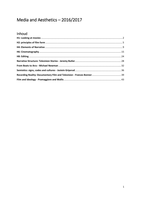Samenvatting
Summary Media Aesthetics: Looking at Movies and articles
- Instelling
- Universiteit Van Amsterdam (UvA)
- Boek
- Looking at Movies
Looking at movies - Richard Barsam & Dave Monahan (5th edition 2016) Summary H1, H2, H4, H6, and H8. All concepts and definitions of each chapter of the book and the additional literature (the articles) are structured and explained and therefore more understandable and easy to learn for everyone. I...
[Meer zien]





